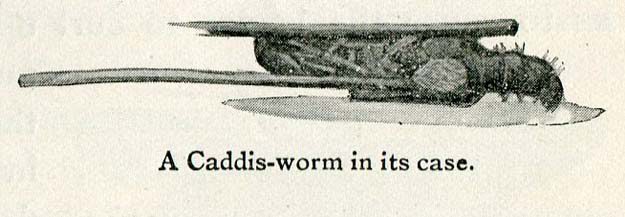S. Silcox & O. J. Stevenson, Modern nature study, A first book for use in Canadian schools, Toronto, George N. Morang, 1902, p. 161.
Clinging to the stones, however, are some objects which you are likely to overlook. They may be mistaken for small snail shells or mere masses of sand. Collect them and observe them at home. You will find that these apparently inanimate masses move about. In fact that each encloses the larva of a Caddis-fly. There are many varieties, which make different kinds of cases of sticks, stones, or leaves. Some are free and some are attached to stones. Examine the undersides of stones where the water of the Stream flows rapidly. You will find small objects such as stones, clam shells and even nails, adhering to the surface. Remove these carefully and you will find that they are attached to each other and to the stone by a sort of network. At one part of the surface of the stone a larger mass of these small objects will be observed. In this will be found a larva of a species of Caddis-fly, an insect related to the Dragon-fly.

